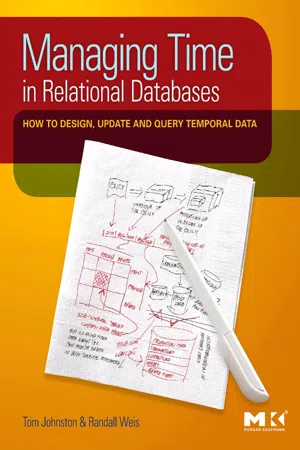
Managing Time in Relational Databases
How to Design, Update and Query Temporal Data
- 512 pages
- English
- ePUB (mobile friendly)
- Available on iOS & Android
Managing Time in Relational Databases
How to Design, Update and Query Temporal Data
About This Book
Managing Time in Relational Databases: How to Design, Update and Query Temporal Data introduces basic concepts that will enable businesses to develop their own framework for managing temporal data. It discusses the management of uni-temporal and bi-temporal data in relational databases, so that they can be seamlessly accessed together with current data; the encapsulation of temporal data structures and processes; ways to implement temporal data management as an enterprise solution; and the internalization of pipeline datasets.
The book is organized into three parts. Part 1 traces the history of temporal data management and presents a taxonomy of bi-temporal data management methods. Part 2 provides an introduction to Asserted Versioning, covering the origins of Asserted Versioning; core concepts of Asserted Versioning; the schema common to all asserted version tables, as well as the various diagrams and notations used in the rest of the book; and how the basic scenario works when the target of that activity is an asserted version table. Part 3 deals with designing, maintaining, and querying asserted version databases. It discusses the design of Asserted Versioning databases; temporal transactions; deferred assertions and other pipeline datasets; Allen relationships; and optimizing Asserted Versioning databases.
- Integrates an enterprise-wide viewpoint with a strong conceptual model of temporal data management allowing for realistic implementation of database application development.
- Provides a true practical guide to the different possible methods of time-oriented databases with techniques of using existing funtionality to solve real world problems within an enterprise data architecture environment.
- Written by IT professionals for IT professionals, this book employs a heavily example-driven approach which reinforces learning by showing the results of puting the techniques discussed into practice.
Frequently asked questions
Information
Table of contents
- Cover Image
- Table of Contents
- Front matter
- Copyright
- About the Authors
- Preface
- Introduction
- 1. A Brief History of Temporal Data Management
- 2. A Taxonomy of Bi-Temporal Data Management Methods
- Introduction
- 3. The Origins of Asserted Versioning
- 4. The Origins of Asserted Versioning
- 5. The Core Concepts of Asserted Versioning
- 6. Diagrams and Other Notations
- 7. The Basic Scenario
- Introduction
- 8. Designing and Generating Asserted Versioning Databases
- 9. An Introduction to Temporal Transactions
- 10. Temporal Transactions on Single Tables
- 11. Temporal Transactions on Multiple Tables
- 12. Deferred Assertions and Other Pipeline Datasets
- 13. Re-Presenting Internalized Pipeline Datasets
- 14. Allen Relationship and Other Queries
- 15. Optimizing Asserted Versioning Databases
- 16. Conclusion
- Appendix. Bibliographical Essay
- The Asserted Versioning Glossary
- Index